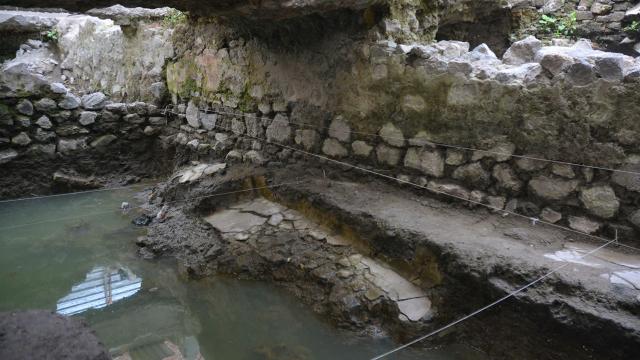Archaeologists in Mexico City have uncovered a pre-Hispanic steambath dating back to the 14th century. Its location in the city’s historic district confirms the whereabouts of a vibrant neighbourhood that once stood in Tenochtitlán—an ancient urban centre that eventually became Mexico City.
The 14th-century steambath, or temazcal as its known in the indigenous Nahuatl language, was discovered by archaeologist Víctor Esperón Calleja and his colleagues from Mexico’s National Institute of Anthropology and History (INAH), according to the institute’s press release. The domed structure is located near La Merced in Mexico City beneath Talavera Street. The temazcal was constructed in the 14th century and was likely used for medicinal and spiritual purposes and even childbirth, reports Mexico News Daily.
The INAH archaeologists also found evidence of a post-colonial house that was inhabited by an indigenous family of noble descent, as well as the remnants of a tannery that was in operation during the 18th century.
Fuelled by the natural hot springs underneath, the temazcal included a tub (basically a pool of water) and a bench for sitting, and the structure was made from blocks of adobe and stucco-coated volcanic rock known as tezontle, according to the INAH archaeologists. Occupants who sat or bathed within the domed structure, which measured 5 meters (16.5 feet) long and 2.98 meters (9.8 feet) wide, could luxuriate and cleanse themselves in the warm steam.
Importantly, the discovery of this temazcal confirms the location of Temazcaltitlan, one of the oldest neighbourhoods in Tenochtitlán, the Mexica capital that eventually became Mexico City.
The discovery also confirms written accounts describing the sweat lodge. Writing in his Crónica Mexicáyotl, Hernando Alvarado Tezozómoc, a Nahua nobleman, described a Tenochtitlán temazcal that was built to bathe and purify a noble Mixiuhca girl named Quetzalmoyahuatzi, and how other townspeople were also welcome to partake in the steambath, according to INAH. Calleja, the leader of the archaeological expedition, said the discovery provides tangible evidence of the temazcal, while also affirming the spiritual and cultural importance of the Temazcaltitlan neighbourhood.
Indeed, evidence gathered prior to this discovery suggested as much, pointing to this location as a place where female deities, including the gods of purification, steambaths, fertility, water, and childbirth, were worshipped, explained Calleja in the press release. Interestingly, residents of Temazcaltitlan also worshipped deities associated with pulque—a pre-hispanic alcoholic drink made from agave and other plants.
To the west of the site, the INAH team found traces of a house likely inhabited by an indigenous family of noble descent, as evidenced by floors made from adobe blocks and walls decorated with red motifs. The archaeologists dated the house to the Early Colonial Period (1521 to 1620). They also found the remnants of a former tannery (a leather manufacturing shop) that was in operation during the New Spain period (1720 to 1820). The tannery likely sourced its leather from cattle slaughtered at a nearby abattoir, according to the researchers.
Looking ahead, the INAH team is hoping to learn more about the neighbourhood and the people who lived there.
